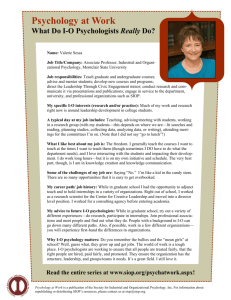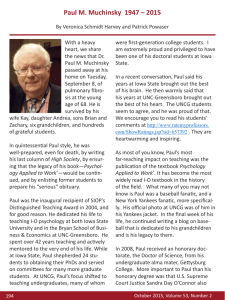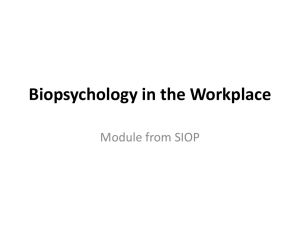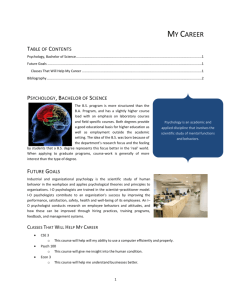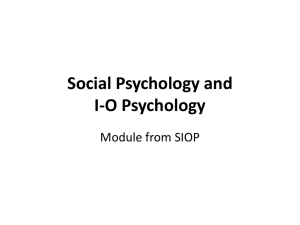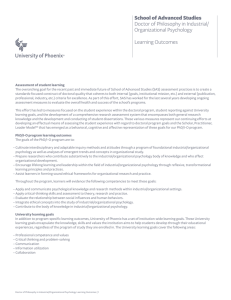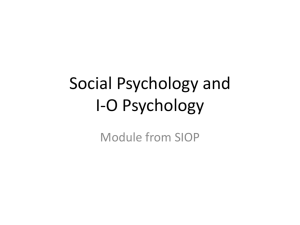Chapter 1 - Work in the 21st Century
advertisement
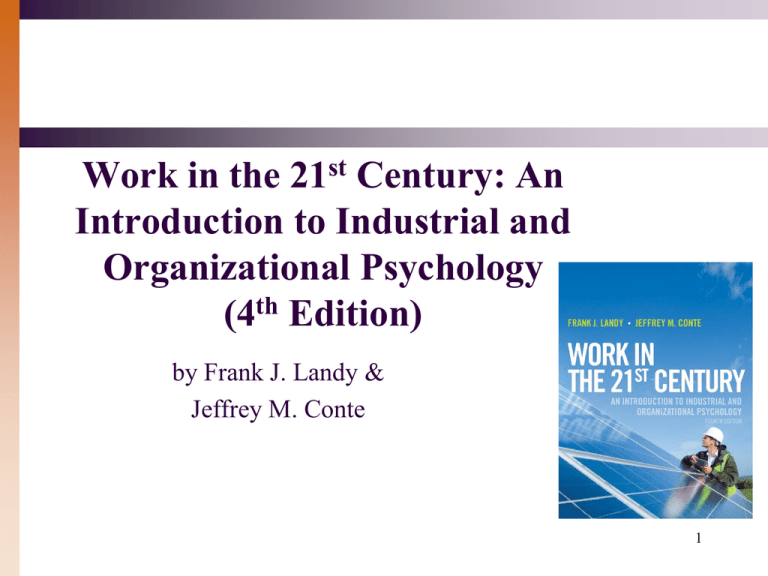
Work in the 21st Century: An Introduction to Industrial and Organizational Psychology (4th Edition) by Frank J. Landy & Jeffrey M. Conte 1 Work in the 21st Century Chapter 1 What is Industrial and Organizational Psychology? 2 Module 1.1: Fundamentals of I-O Psychology • Importance of I-O psychology – Importance of work in people’s lives • What is I-O psychology? – The application of psychological principles, theory, and research to the work setting. 3 Fundamentals of I-O Psychology (cont’d) – SIOP (Division 14 of APA) – Fields of I-O Psychology • Personnel psychology • Organizational psychology • Human engineering 4 Relatively New Topics of Interest to I-O Psychology • Building sustainable and environmentally conscious organizations – I-O psychologists can guide organizations in measuring their eco-benefits and in promoting these benefits along with individual, team, and organizational performance. • Humanitarian work psychology (HWP): the application of I-O psychology to humanitarian arena, especially poverty reduction and promotion of decent work, aligned with local stakeholders’ needs, and in partnership with global aid/development groups. – Led by New Zealand I-O psychologist Stuart Carr, initial work in this field shows that I-O psychologists can make a difference in some of the major global problems of the 21st century. 5 SIOP as a Resource • www.siop.org – – – – – History of I-O psychology Membership information (including students) Quarterly newsletter: TIP JobNet SIOP Journal – I-O Psychology: Perspectives on Science and Practice – Graduate training programs in I-O psychology – List of SIOP publications 6 Common Areas of Concentration for I-O Psychologists Table 1.1 7 Common Job Titles for I-O Psychologists Table 1.2 8 Evidence-Based I-O Psychology • I-O psychologists have become increasingly focused on making evidence-based decisions in their work in organizations • This includes using a decision-making process that combines critical thinking with use of best available scientific evidence. • I-O psychologists are well positioned to develop and utilize evidence-based practices as they have adopted the scientist-practitioner model to guide the field. 9 How This Course Can Help You • Knowledge about 21st century workplace – Course will address issues such as work stress, workfamily balance, workplace discrimination, & leadership 10 Module 1.2: The past, present, and future of I-O Psychology • The Past – Important Dates/Events in I-O Psychology • The Present – Demographics and Career Paths • Future Challenges to I-O Psychology 11 Titles of Research Articles in JAP (1917) Table 1.3 12 Titles of Research Articles in JAP (2008) Table 1.4 13 Brief History of I-O Psychology • 1876-1930 – Hugo Munsterburg, James McKeen Cattell, Walter Dill Scott, & Walter Van Dyke Bingham – World War 1: Army Alpha & Army Beta Tests – 1917 – First Ph.D. in Industrial Psychology awarded to Lillian Gilbreth • Research in time & motion study → Human Engineering 14 Brief History of I-O Psychology (cont'd) • 1930-1964 – Hawthorne Studies, Human Relations – Human relations movement • Theories of motivation • Emotional world of the worker • Studies of job satisfaction – WWII – Civil Rights Act of 1964 & Title VII 15 Civil Rights Act of 1964 & Title VII Title VII specified demographic groups to be protected from employment discrimination • Groups named in 1964 – Race – Color – Gender – National origin – Religion • 2 additional protected groups added later – ADEA (age) 1967 – ADA (disability) 1990 16 Important Dates in the Evolution of I-O Psychology Figure 1.1 17 Demographics of I-O Psychologists • In 2000, I-O psychologists represented about 6% of all APA members • In 2000, 30% of I-O psychologists in APA were women • Average salaries: – Ph.D. in I-O psychology: $90,000 – Masters in I-O psychology: $67,000 18 Figure 1.2: Where I-O Psychologists are Employed 19 Preparing for a Career in I-O Psychology • Education & training • Getting into a graduate program – Consideration of GPA & GRE score(s) – Relevant coursework (e.g., statistics) • More emphasis on coursework than major 20 Challenges to I-O in 21st Century • I-O psychology needs to be: – Relevant – Useful – Grounded in scientific method 21 Changes in the Workplace Since 1980 • Personal computing • Telecommuting & virtual teams • Videoconferencing • Providing a service vs. manufacturing “goods” • Nature of work more fluid • Teams vs. the individual • Little stability • Family-friendly workplaces • Greater diversity • Global workplace Milton Montenegro/Getty Images 22 Module 1.3: Multicultural & CrossCultural Issues in I-O Psychology • Multiculturalism – Culture defined • System in which individuals share meaning & common ways of viewing events & objects • Sharing of meanings & interpretations Royalty-Free/CORBIS 23 Cultural Determinants in the Workplace (Triandis) Figure 1.3 The Dynamic of Top-Down-Bottom-Up Processes across levels of culture 24 Multicultural Nature of Work in the 21st Century • Why should multiculturalism be important to you? • Why is multiculturalism important for I-O psychology? – Issues surrounding the global economy, expatriates, & the “West vs. the Rest” mentality 25 Theory of Cultural Influence (Hofstede) Table 1.5 The Five Dimensions of Hofstede’s Theory of Culture 26 Figure 1.4: Cultural Differences among Countries (Hofstede, 1993) 27 Thoughts on Theories of Cultural Influence • Triandis’ variation on Hofstede’s dimension of individualism/collectivism – Horizontal cultures – those that minimize distances between individuals – Vertical cultures – accept & depend on distances between individuals 28 Implications of Cultural Dimensions for HRM Table 1.6 The implications of Cultural Dimensions for HRM 29 Cultural Determinants in the Workplace (Triandis) Figure 1.5 Triandis’s View of Cultural Determinants in the Workplace 30 Module 1.4: Themes & Course Structure • Themes: A) Unified Science B) Holistic Approach • Parts of the book: 1) Introduction 2) Industrial Psychology 3) Organizational Psychology 4) Work Environment 31 Module 1.4 (cont’d) • Resources – Paper (I-O Journals/Books) – Electronic: I-O websites (e.g., www.siop.org) • Case study – Provides example of complexity of work behavior 32 Table 1.7: Scientific Journals in I-O Psychology 33 Table 1.8: Practical Texts in I-O Psychology 34
